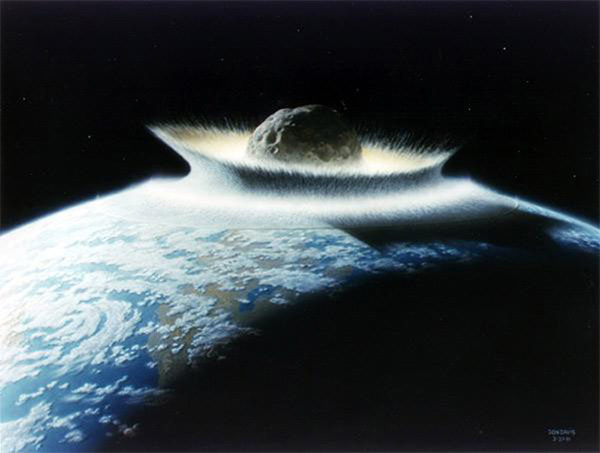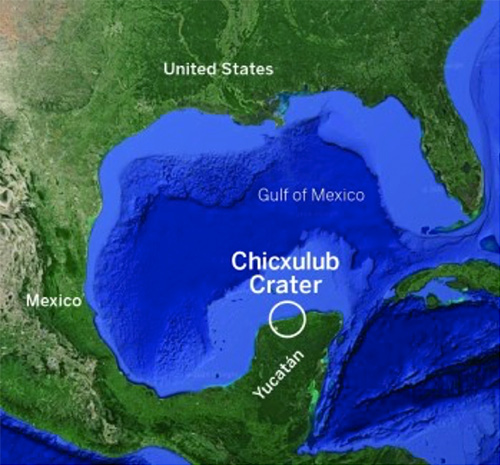
We talked about the asteroid that, 66 million years ago, ended the age of dinosaurs. But what exactly did it do to the planet?
From the point of impact, a blast wave of heat rushed outward at nearly the speed of light, followed by scorching winds that reached 500 miles an hour.
These were followed by a massive earthquake felt around the world that may have caused landslides across the planet.
Shortly after came tsunami waves up to 1,000 ft high, racing across the Gulf of Mexico and traveling many miles inland, up the Mississippi River, covering Caribbean islands and swamping Atlantic coastlines.
Debris from the impact rained across the region, forming deposits up to 1,000 ft thick. The debris was hot enough to ignite massive wildfires across North America that may have burned for months.
And the long-term effects were even worse!
Ash and dust blocked out sunlight, while billions of tons of vaporized rock formed aerosols that blocked the sun’s heat.
In this cold twilight, the surface temperature of Earth fell as much as 40 degrees Fahrenheit and stayed that way for 15 to 20 years.
Mere decades later, once the aerosols settled out, greenhouse gases from the wildfires helped to warm the atmosphere more than 10 degrees higher than pre-impact.
It’s amazing that anything survived this destruction!
But it actually paved the way for… you and me, which we’ll talk about on another EarthDate.
Background

Synopsis: The 150-million-megaton Chicxulub impact caused the extinction of three quarters of the species on Earth and ended the 200-million-year reign of the dinosaurs. In a geologic instant, the Mesozoic era was gone and the Cenozoic era started. But the blast wasn’t the big killer—the darkness was!
- The Chicxulub asteroid impact 66 million years ago had disastrous effects on Earth.
- The moment of impact vaporized rock at the site and formed a 100-km-wide and 30-km-deep transient crater.
- The impact generated energy equivalent to a magnitude 10 or 11 earthquake that would have been felt globally.
- Tsunami waves 50–300-m-high left the crater and crossed the Gulf of Mexico, rushing at least 100 km onshore along the Cretaceous coastline, extending into Arkansas and Missouri within the Mississippi Embayment and northward toward Colorado within the Western Interior Seaway. They also swamped Caribbean and Atlantic coastlines, depositing rubble. In places, their tremendous backwash eroded the seafloor by several hundred meters.
- Earthquake energy traveling through Earth’s crust induced local landslides that caused additional tsunamis. The Hell Creek area of Montana, Wyoming, and the Dakotas within the Western Interior Seaway shows evidence of a tsunami with iridium and glassy debris from the ejecta contained within it. Fossil fish gills packed with glass were found above dinosaur tracks in the rocks below the tsunami deposit.
- An expanding thermal radiative plume of intense heat rushed outward from the impact site at nearly the speed of light.
- Winds of up to 1,000 km/hr were produced near the site, decreasing outward to distances of up to 1,800 km.
- Less than 5 minutes after impact, the collapse of the transient crater resulted in a 200-km-wide by 1-km-deep impact basin—much like the wide, flat impact basins we see on the moon. More than 3 km of melt rock pooled in the center of the crater, surrounded by a peak ring of shattered rock rising around 600 m above the crater floor.
- Ejecta and debris began to rain down all around what is now the Gulf of Mexico region, forming 50–300-m-thick deposits as far away as 600 km.
- Carbon-based debris and soot found in rock deposits along the global boundary suggest that ejecta and molten spherules heated the atmosphere, igniting massive wildfires in North America that may have burned for months, releasing soot, carbon dioxide, carbon monoxide, and methane. The global extent of these wildfires is the subject of debate.
- The asteroid’s longer-lasting effects were even worse! Soon after the initial devastation subsided, Earth’s atmosphere went dark and cold, followed by a long period of twilight; this was the ultimate blow that resulted in the extinction of so much life.
- The impact vaporized nearly 1,000 gigatons of rock, nearly a third of which were sulfate-bearing evaporites (such as anhydrite and gypsum) deposited along the Cretaceous coast of Mexico—similar to sabkha deposits found in places like today’s Arabian Gulf.
- These vaporized sulfates were ejected into the stratosphere, where they combined with water vapor to form sulfate aerosols. Tiny sulfate aerosols are particularly effective at reflecting incoming solar radiation, and they persist for long periods in the stratosphere.
- The stratosphere is stratified into layers by temperature. Once particles are introduced into it, they become distributed laterally around Earth, above the mixing action of Earth’s weather systems. The blanket of aerosols caused Earth’s surface to cool dramatically, with global temperatures dropping more than 20oC for 15–20 years.
- Decades later, when the aerosols finally settled out of the stratosphere, greenhouse warming may have occurred from CO2, water, and methane still circulating in the troposphere after the impact. Fossilized leaves suggest the amount of heating ranged from 1oC to 7.5oC.
- With most incoming sunlight blocked by aerosols, Earth was almost completely dark for months and dim for years after that.
- Photosynthesis shut down, leading to food-chain collapse on land and in the seas, causing starvation and extinction. Estimates suggest that very little photosynthesis occurred for about 2 years and that it may have taken around 6 years for photosynthesis to return to pre-impact levels.
- The massive Deccan Traps eruptions in India, which started 250,000 years before and continued 500,000 years after the Chicxulub impact, appear to have been affected by the blast, with some evidence indicating the volume of eruptions may have increased around the time of impact.
- The Chicxulub impact changed the history of Earth and made it possible for mammals to dominate—and for humans to evolve. We’ll talk more about the recovery of life in the next EarthDate.

